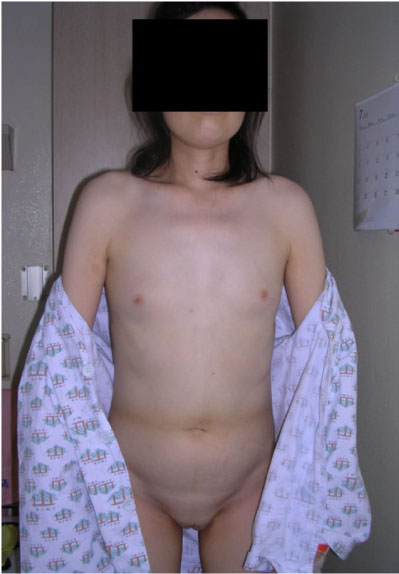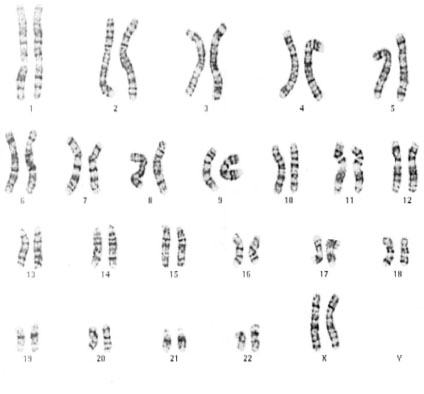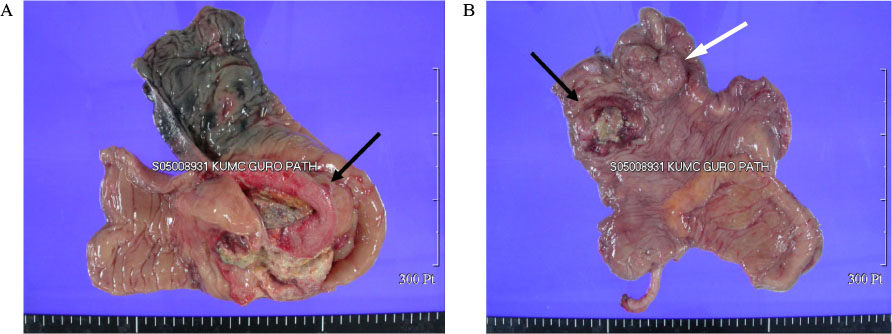J Korean Endocr Soc.
2006 Oct;21(5):414-418. 10.3803/jkes.2006.21.5.414.
A Case of Colon Cancer in Mayer-Rokitansky-Kuster-Hauser (MRKH) Syndrome with Gonadal Agenesis
- Affiliations
-
- 1Department of Internal Medicine, Guro Hospital, Korea University School of Medicine, Korea.
- KMID: 1511992
- DOI: http://doi.org/10.3803/jkes.2006.21.5.414
Abstract
- Mayer-Rokitansky-Kuster-Hauser (MRKH) syndrome is the second frequent cause of primary amenorrhea. There have been several reports concerning gynecologic disease in MRKH syndrome, but there has been no case about a colon cancer in a patient with this condition. A 43 years old woman, who reported primary amenorrhea with sexual infantilism, was evaluated in our department because of lower abdominal pain: she presented with a suprapubic mass. To evaluate the suprapubic abdominal mass and primary amenorrhea, abdominal MRI, colonoscopy and endocrine tests were done. She had no gynecologic organs, and she finally was diagnosed as having colon cancer with the atypical form of MRKH syndrome (bilateral gonadal agenesis 46 XX). To the best of our knowledge this is the first case concerning primary colon cancer in a patient with MRKH syndrome.
MeSH Terms
Figure
Reference
-
1. Kim BY, Woo JT, Kim SW, Yang IM, Kim YS, Kim KW, Choi YK. A case of Rokitansky-Küster-Hauser syndrome. J Kor Soc Endocrinol. 1992. 7:422–423.2. Lee KB, Shin SE, Kim MK, Lim HB, Min BK. Two case of Rokitansky-Küster-Hauser syndrome. J Kor Soc Obstet Gynecol. 1984. 27:2176–2181.3. Aydos S, Tkn A, Bokesoy I. Gonadal dysgenesis and the Mayer-Rokitansky-Küster-Hauser (MRKH) syndrome in a girl with 46Xdel (pter → q22). Arch Gynecol Obstet. 2003. 267:173–174.4. Gorgojo JJ, Almodovar F, Lopez E, Donnay S. Gonadal agenesis 46,XX associated with the atypical form of Rokitansky syndrome. Fertil Steril. 2002. 77:185–187.5. Marrakchi A, Gharbi M, Kadiri A. Gonadal dysgenesis associated with Mayer-Rokitansky-Küster-Hauser syndrome. Ann Endocrinol (Paris). 2004. 65:466–468.6. Oppelt P, Renner SP, Kellermann A, Brucker S. Clinical aspects of Mayer-Rokitansky-Küster-Hauser syndrome. Recommendations for clinical diagnosis and staging. Hum Reprod. 2006. 21:792–797.7. Tewari DS, McHale MT, Kuo JV, Monk BJ, Burger RA. Primary invasive vaginal cancer in the setting of the Mayer-Rokitansky-Küster-Hauser syndrome. Gynecol Oncol. 2002. 85:384–387.8. Burel A, Mouchel T, Odent S, Tiker F, Knebelmann B, Pellerin I, Guerrier D. Role of HOXA7 to HOXA13 and PBX1 gene in various forms of MRKH syndrome (congenital absence of uterus and vagina). J Negat Results Biomed. 2006. 5:4.9. Guerrier D, Mouchel T, Pasquier L, Pellerin I. The Mayer-Rokitansky-Küster-Hauser syndrome (congenital absence of uterus and vagina)-phenotypic manifestations and genetic approaches. J Negat Results Biomed. 2006. 5:1.10. Bidus MA, Martin JN, Magann EF. Mayer-Rokitansky-Küster-Hauser syndrome presenting as an inguinal mass and hernia in the female patient. J Pelvic Med Surg. 2004. 10:193–195.11. Pittock ST, Dusica BV, Lteif A. Mayer-Rokitansky-Küster-Hauser anomaly and its associated malformations. Am J Med Genet. 2005. 135:314–316.12. Ulrich U, Schrickel J, Dorn C, Richter O, Lewalter T, Lderitz B, Rhiem K. Mayer-von Rokitansky-Küster-Hauser syndrome in association with a hitherto undescribed variant of the Holt-Oram syndrome with an aorto-pulmonary window. Hum Reprod. 2004. 19:1201–1203.13. Kurt A, Gultash N, Yazicioglu KR, Ipek A, Dilmen G, Tas I. Hypothyroidism associated to Mayer-Rokitansky-Küster-Hauser syndrome in a 21 year old patient with primary amenorrhea. Eur J Gen Med. 2004. 1:65–67.14. Edmonds DK. Vaginal and uterine anomalies in the paediatric and adolescent patient. Curr Opin Obstet Gynecol. 2001. 13:463–467.
- Full Text Links
- Actions
-
Cited
- CITED
-
- Close
- Share
- Similar articles
-
- A Case of Mayer-Rokitansky-Kuster-Hauser (MRKH) Syndrome with Bilateral Gonadal Agenesis
- A Case of Mayer-Rokitansky-Kuster-Hauser (MRKH) Syndrome with Amenorrhea and Sexual Precosity
- A Case of Uterine Leiomyomas in both Rudimentary Uterine Horns in a Woman with the Mayer-Rokitansky-Kuster-Hauser Syndrome
- A Case of Mayer-Rokitansky-K ster-Hauser(MRKH) Syndrome with Imperforate Anus and Unilateral Renal Agenesis
- MR Findings of Mayer-Rokitansky-Kuster-Hauser Syndrome: Two Cases Report




